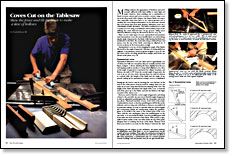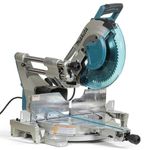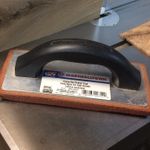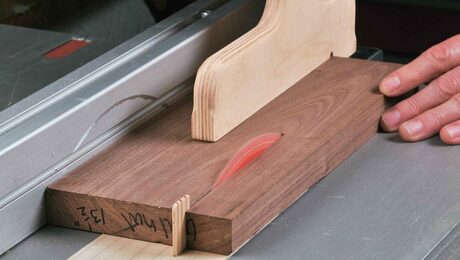Coves Cut on the Tablesaw
Skew the fence and tilt the blade to make a slew of hollows
Synopsis: Frank Klausz III, who studied cove cutting for his Harvard thesis, explains in this article how to cut symmetrical and asymmetrical coves on the tablesaw with a simplified set-up process. He also addresses safety issues. For symmetrical coves, he skews the fence slightly to produce a steep-sided elliptical cove, then, as the angle of approach is increased, the ellipse broadens and flattens out until the cove is an arc of a true circle. Then he talks about finding asymmetrical coves by eye and by CAD-generation, and explains partial coves.
Moldings enhance the appearance of furniture and architectural millwork with their ability to catch light and make shadows. Most moldings are a combination of beads (convex curves) and coves (concave curves). Large coves are most often made with a shaper, but shaper blades are expensive, especially when they have to be custom ground—not to mention the cost of shapers themselves. So for short runs of molding or for shops that don’t have shapers, tablesawn coves are a surprisingly versatile alternative. This article explains how to make a variety of coves using your tablesaw and examines ways of simplifying the usual trial-and-error set-up process. Safety issues raised by tablesaw coving are discussed in the box on p. 84.
There are two main types of coves: symmetrical and asymmetrical. Symmetrical coves, the more familiar kind, are cut by changing the angle of approach to the blade while leaving the blade perpendicular to the table. The stock rides along a skewed fence and passes over the top of the blade, removing an elliptical arc of wood, as shown in the bottom photo at right.
Asymmetrical coves are cut by changing the angle of the blade’s tilt as well as the angle of approach. This type of coving yields logarithmic, or accelerated, curves as shown in figure 2 on p. 85. Partial coves can be cut using special fence setups, such as the one shown in the photo on p. 85.
Symmetrical coves
Symmetrical tablesawn coves are often used to approximate arcs of circles, but with one exception, they are actually sections of ellipses. As figure 1 shows, skewing the fence slightly from the normal ripping position produces a steep-sided elliptical cove; then, as the angle of approach is increased, the ellipse broadens and flattens out until, at 90° from the normal angle of approach, the cove is an arc of a true circle. Because there are only two factors to contend with, the height of the blade and the angle of approach, setting up for symmetrical coving is not too complicated.
From Fine Woodworking #102
Fine Woodworking Recommended Products

Rockler Dust Right 1250 CFM

Makita LS1219L Miter Saw

Grout float





















Log in or create an account to post a comment.
Sign up Log in